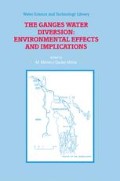Abstract
Rivers and streams with their associated flood basins and upland areas form complexly linked ecosystems in which land, water, plants, animals and humans interact and evolve in response to the interactions of the components of the system. Thus changes in any component of the system will impact the physical, chemical, and biological process occurring within the river system. River systems normally function within the natural ranges of flow, sediment movement, temperature and other variables, in what is termed “dynamic equilibrium.” When changes in these variables go beyond their natural ranges, dynamic equilibrium may be lost, often resulting in adjustments that are detrimental to the integrity of the ecosystem, which includes ecosystem structure, ecological process, regional and historical context, and sustainable cultural practices.
Access this chapter
Tax calculation will be finalised at checkout
Purchases are for personal use only
Preview
Unable to display preview. Download preview PDF.
References
Abernethy, Y. and Turner, R.E.: 1987, U.S. Forested Wetlands: 1940–1980, Bioscience 37(10), 21–727.
Bangladesh Water Development Board (BWDB): 1977, Special Studies, BWDB, Dacca.
Bunt, J.S., Williams, W.T. and Clay, H.J.: 1982, River water salinity and the distribution of mangrove species along several rivers in North Queensland, Australian Journal ofBotany 9, 111–120.
Chaffey, D.R., Millar, F.R. and Sandoun, J.H.: 1985, A Forest Inventory ofthe Sundarbans, Bangladesh, Land Resource Development Center, U.K.
Chantarasri, S.: 1994, Integrated Resource Development of the Sundarbans Reserved Forest, Fisheries Resources Management for the Sundarbans Reserved Forest, UNDP/FAO, Khulna, Bangladesh.
Ciesla, W. and Donaubaur, E.: 1994, Decline and Dieback of Trees and Forests: A Global Overview, Food and Agriculture Organization of the United Nations (FAO) Forestry Paper # 120, FAO, Rome.
Curtis, S.J.: 1933, Working Plan for the Sundarbans Division for the period from April 1st 1931-March 31.st 1951, Bengal Government Press, Calcutta.
Environment and Geographic Information Services (EGIS): 2001, Environmental and Social Impact Assessment of Gorai River Restoration Project-Volume II: Annexes, EGIS, Dhaka.
Food and Agriculture Organization of the United Nations (FAO): 1995, Integrated Resource Management Plan of the Sundarbans Reserved Forest, FAO/UNDP, Dhaka.
Forestry and Engineering International Ltd. (FORESTAL): 1960, Forest Inventory 1958–1959 Sundarbans, FORESTAL, Vancouver, Canada.
Forest Resource Management Project (FRMP): 1995, Report on Forest Resource Management Project (FRMP), Department of Forest, Government of Bangladesh, Dhaka.
Forest Resource Management Project (FRMP): 1998, Report on Forest Resource Management Project (FRMP), Department of Forest, Government of Bangladesh, Dhaka.
Forest Resource Management Project (FRMP): 2000, Report on Forest Resource Management Project (FRMP), Department of Forest, Government of Bangladesh, Dhaka.
Gordon, M.S. and Tucker, V.A.: 1965, Osmotic regulation in the tadpoles of the crab eating frog Rana cancrivora, J. Experimental Biology 42, 437–445.
IUCN: 1994, Mangroves of the Sundarbans Volume II: Bangladesh (Z. Hussain and G. Acharya Eds.), IUCN, Bangkok.
Karim, A.: 1993, Plant diversity and their conservation in freshwater wetland, In: A. Nishat, Z. Hossain, M.K. Roy and A. Karim (Eds.), Wetlands in Bangladesh, IUCN, Gland, Switzerland.
Karim, A.: 1994, The physical environment. In: Mangroves ofthe Sundarbans Volume II: Bangladesh (Z. Hussain and G Acharya Eds.), IUCN, Bangkok.
Karim, A.: 1995, Ecological Implications of the Changing Natural Flow of Water on the Ganges River Ecosystem. In: H.J. Moudud (Ed.) Women for Water Sharing, Academic Publishers, Dhaka.
Karim, A.: 1988, Environment factors and the distribution of mangroves in the Sundarbans with special reference to Sundric C. Heritiera fomes, unpublished PhD Thesis, University of Calcutta, Kolkata, India.
Karr, J. R.: 1996, Ecological integrity and ecological health are not the same, In: P. Schulze (Ed.) Engineering Within Ecological Constraints, National Academy Press, Washington, D.C.
Khan, M. A. R.: 1986, Wildlife in Bangladesh mangrove ecosystem. Journal of the Bombay Natural History Society 83, 32–48.
Khan, M. A. R.: 1982, Wildlife ofBangladesh, a checklist. University of Dhaka, Dhaka.
Milward, N.E.: 1982, Mangrove-dependent bioto, In: B.F. Clough (Ed.), Mangrove Ecosystems in Australia, Australian National University Press, Canberra, 56–62.
Overseas Development Administration (ODA): 1984, Forest Inventory of the Sundarbans, ODA, London, UK.
Saenger, P., Specht, M., Specht, R.L. and Chapman, V.J.: 1977, Mangal and coastal salt-marsh communities in Australia. In (V.J. Chapman Ed.), Ecosystems of the World, Vol. I: Wet Ecosystems, 293–345.
Sarker, S. U. and Sarker, N. J.: 1986, Status and distribution of birds of the Sundarbans, Bangladesh, The Journal of Naomi 3: 19–33.
Sarker, S.U.: 1993, Ecology of Wildlife UNDP/FAOBGD/85/011, Field Document # 50, Institute of Forestry and Environmental Sciences, Chittagong, Bangladesh.
Scott, D.A.: 1991, Asia and the Middle East Wetlands. In: M. Finlayson and M. Moser (eds.), Wetlands, Oxford, UK.
Seidensticker J. and M. A. Hai: 1983, The Sundarbans Wildlife Management Plan: Conservation in the Bangladesh Coastal Zone, International Union for the Conservation of Nature and Natural Resources (IUCN), Gland, Switzerland.
Surface Water Modeling Center (SWMC): 2000, Options for the Ganges Dependent Area, SWMC, Dhaka (www.iwmbd.org/html/proj-5269.htm).
Thom, B.G.: 1982, Mangrove ecology: A geomorphological perspective. In: B.F. Clough (Ed.), Mangrove Ecosystems in Australia, Australian National University Press, Canberra, 3–17.
Author information
Authors and Affiliations
Editor information
Editors and Affiliations
Rights and permissions
Copyright information
© 2004 Springer Science+Business Media Dordrecht
About this chapter
Cite this chapter
Karim, A. (2004). Implications on Ecosystems in Bangladesh. In: Mirza, M.M.Q. (eds) The Ganges Water Diversion: Environmental Effects and Implications. Water Science and Technology Library, vol 49. Springer, Dordrecht. https://doi.org/10.1007/978-1-4020-2792-5_7
Download citation
DOI: https://doi.org/10.1007/978-1-4020-2792-5_7
Publisher Name: Springer, Dordrecht
Print ISBN: 978-90-481-6665-7
Online ISBN: 978-1-4020-2792-5
eBook Packages: Springer Book Archive

